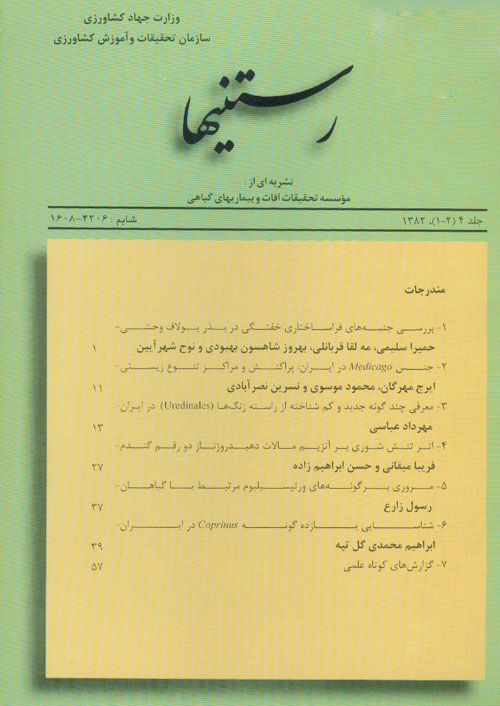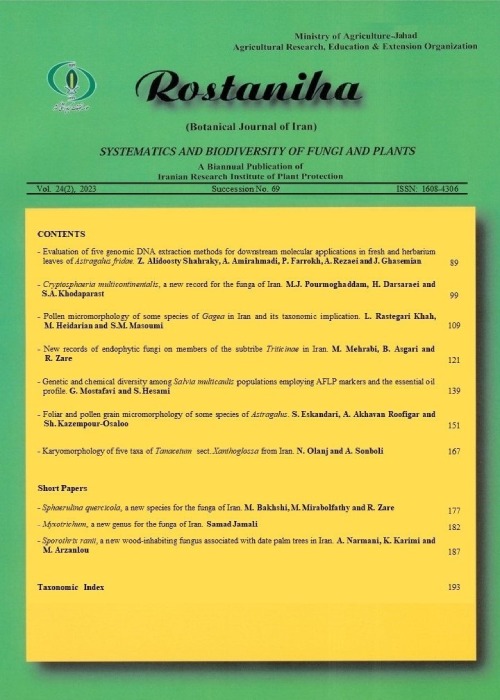فهرست مطالب

نشریه رستنیها
سال چهارم شماره 1 (پیاپی 16، بهار و تابستان 1382)
- 126 صفحه،
- تاریخ انتشار: 1381/12/27
- تعداد عناوین: 7
-
-
صفحه 1تفاوتهای ساختاری و فراساختاری بذور خفته و غیر خفته یولاف وحشی (Avena توسطludoviciana)توسط میکروسکوپ نوری و الکترونی (TEM) بررسی گردید. پس از جذب آب، رشد شعاعی سلولهای روپوششی (epithelial) لپه در بذور غیر خفته مشاهده گردید. در بذور خفته، سلولهای مذکور رشد نیافته و به صورت متراکم و فشرده وجود داشتند. هضم دانه های چربی و آلورون درون سلول و در نتیجه رقیق شدن سیتوپلاسم، توسعه شبکه آندوپلاسمی، افزایش تعداد پلی زومها و تجمع آنها، افزایش تعداد میتوکندری، مشاهده حضور یک واکوئول بزرگ در سلول، تغییرات فراساختاری موجود در سلول های بذور غیر خفته بود که در بذور خفته مشاهده نگردید. در بذور خفته و اکوئول های کوچک و متعدد، تعداد زیادی دانه های چربی و آلورون وجود داشت.
کلیدواژگان: یولاف وحشی، بذر، خفتگی، ساختار، فراساختار -
صفحه 11پراکنش زیستی جنس یونجه در ایران مطالعه گردید. پراکنش گونه های چند ساله M.sativa و M.lupulina عمدتا منطبق با نواحی کوهستانی ایران است. از بین دیگر گونه های این جنس، پراکنش M.rigdula بیشترین شباهت را با گونه های قبلی در مناطق کوهستانی دارد. اغلب گونه های یونجه در مناطقی با شرایط آب و هوایی مدیترانه ای رویش دارند. مطابق این تحقیق، یک مرکز اصلی و دو مرکز فرعی تنوع زیستی برای این جنس در ایران تشخیص داده می شود.
محتمل ترین مسیر برای مهاجرت گونه های یکساله یونجه به داخل ایران، از سمت غرب و از طریق مناطق شمالی عراق می باشد (متن کامل مقاله در قسمت انگلیسی ارایه شده است).
کلیدواژگان: یونجه (Medicago)، پراکنش زیستی، ایران، تنوع زیستی -
صفحه 13در این تحقیق تعداد 7 گونه از زنگ های ایران متعلق به و جنس Puccinia و Uromyces گزارش می شوند. گونه های Puccinia leveillei روی Geranium sylvaticum، P.libanotidis روی Libanotis، P.podospermi روی Scorzonera umberosa برای فلور زنگ های ایران جدید می باشند. سیار گونه های بررسی شده عبارتند از: P.campanulae و P.gaubae روی Campanula spp. و U.bupleuri روی. Bupleurum exaltatum اطلاعات متنوعی در مورد خصوصیات مرفولوژیکی، دامنه میزبانی و پرکنش این گونه ها نیز ارایه می گردد.
کلیدواژگان: فلور، زنگ قارچ، ایران، Uredinales، Puccinia، Uromyces -
صفحه 27اثر تیمارهای متفاوت شوری سدیم کلرید (0، 50، 100، 200، 300 میلی مولار) در مراحل مختلف رشد و نمو (پنجه زنی، تورم غلاف، گلدهی و گرده افشانی) دو رقم گندم (قدس: حساس به شوری؛ بولانی: مقاوم به شوری) بر فعالیت سینتیکی و الگوی الکتروفورزی آنزیم مالات دهیدروژناز برگ در شرایط گلخانه ای مورد بررسی قرار گرفت. در مجموع، در پاسخ به تیمارهای شوری مشاهده شد که: افزایش فعالیت مالات دهیدروژناز تنها طی پنجه زنی و تورم غلاف معنی دار بود و این فعالیت بین قدس و بولانی تفاوت معنی داری نشان نداد. الگوی الکتروفورزی مالات دهیدروژناز نیز طی مراحل پنجه زنی و تورم غلاف تغییراتی نشان داد و از این نظر تفاوت چشمگیری بین قدس و بولانی وجود نداشت. بنابراین، به نظر می رسد تنش شوری تنها طی مراحل اولیه زندگی (پنجه زنی و تورم غلاف)، قادربه القای تغییرات قابل ملاحظه در فعالیت سینتیکی و الگوی الکتروفورزی آنزیم مالات دهیدروژناز رقمهای مورد مطالعه می باشد.
کلیدواژگان: تنش شوری، نیترات ردوکتاز، گندم -
صفحه 37روش های مولکولی جهت ارزیابی معیارهای تاکسونومیکی ورتیسیلیومهای مرتبط با گیاهان مورد استفاده قرار گرفتند. سی و یک استرین ورتیسیلیوم به وسیله مقایسه ITS-RELPs به چهار کلاستر تقسیم شدند. کلاستر اول در برگیرنده استریلهای گونه تیپ V. luteo-album (Link: Fries) Subramanian کلاستر دوم شامل V. dahliae klebahn، V. albo-atrum Reinke & Berthold، V. nubihni pethybridge، V. tricorpus Isaac؛ کلاستر سوم شامل V. theobromae (Turconi) E. Mason & S. Hughes و کلاستر چهارم شامل V. nigrescens pethybridge بود. الگوهای RFLP به دست آمده از ژن بتا توبولین(β-tubulin gene) قدرت تفکیک بالاتری داشته و هر هفت گونه مورد آزمایش را از یکدیگر تشخیص دادند. بالاترین قدرت تفکیک از الگوهای RFLP حاصل از DNA میتوکندریایی (mitochondrial DNA-RFLPs) به دست آمد، به طوری که این روش استرین های گونه های V. theobromae و V. nigrescens را در سطح فراگونه ای از یکدیگر تفکیک نمود. برش ژن بتاتوبولین توسط آنزیم برش دهنده Hae III و مقایسه الگوهای به دست آمده روشی قابل اعتماد برای تفکیک دو گونه مهم اقتصادی و بحث برانگیز V. albo-atrum و V. dahliae می باشد.
کلیدواژگان: ورتیسیلیوم، روش های مولکولی، تاکسونومی -
صفحه 39طی سالهای 1371 تا 1379 نمونه های متعددی از قارچهای کلاهدار، راسته Agaricales، از نقاط مختلف استان تهران و مازندران جمع آوری و مورد شناسایی قرار گرفت. در بین گونه های شناسایی شده، 16 گونه متعلق به جنس Coprinus وجود داشت که نه گونه Coprinus lagopus، C. niveus، C. flocculosus، C. comatus، C. scobicola، C. disseminatus، C. plicatilis، C. picaceus و C. macrocephalus قبلا از ایران گزارش شده و هفت گونه دیگر شامل C. angulatus، C. cinereus، C. brunneofibrillosu، C. lagopides، C. ephemeroides، C. subimpatiens و C. patouillaridii برای فلورقارچی ایران جدید می باشند. این هفت گونه همراه با چهارگونه C. lagopus، C. niveus، C. picaceus و C. macrocephalus توصیف گردیده اند.
کلیدواژگان: Agarivales، Coprinus، مورفولوژی، طبقه بندی، ایران -
صفحه 57
-
Page 1The structural differences between dormant and nondormant seeds of wild oats (Avena ludoviciana Durieu) were studied by light and transmission electron microscopy. Radial elongation of scutellum epithelial cells were observed in nondormant seeds after imbibition, compared with dormant seeds in which cells were completely compressed. Ultrastructural differences for example, dilution of cytoplasm, digestion of lipid and aleurone grains, enlarged endoplasmic reticulum, increase and assembly of polysomes and mitochondria, presence of a big vacuole were observed in nondormant seeds. Electron microscopy did not reveal such changes in dormant seeds. Nevertheless a lot of spherosomes, aleurone grains and some small vacuole were observed in the cytoplasm.Keywords: Avena ludoviciana, Seed, Dormancy, structure, ultrastructure
-
Page 11Biodiversity of the genus Medicago in Iran was studied. Distribution of two perennial species M. sativa and M. lupulina mainly conforms to the mountainous regions of Iran. Among the other annual species of this genus, M. rigidula has the most similar distribution to the distribution of perrenial species in mountainous regions. Most species of Medicago (apart from M. sativa and M. lupulina) are distributed in regions with Mediterranean climates. One major and two minor variation centers for the genus Medicago in Iran were identified. The most possible route for species to enter Iran is from the West via North Iraq.Keywords: Medicago, biodiversity, Iran, variation center Introduction
-
Page 13Five species of Puccinia and two of Uromyces making 7 rust-host combinations are reported from Iran. Puccinia leveillei on Geranium sylvaticum, P. libanotidis on Libanotis transcaucasica, P. podospermi on Scorzonera laciniata and Uromyces scrophulariae on Scrophularia umbrosa are reported as new to the flora of Iran. For other three species viz. P. campanulae and P. gaubae on Campanula spp. and U. bupleuri on Bupleurum exaltatum, new morphological features, new hosts and new localities are also reported.Keywords: flora, Rust, Fungus, Iran, Uredinales, Puccinia, Uromyces
-
Page 27Effect of various NaCI treatments (0, 50, 100, 200 and 300 mM) at different growth and development stages (tillering, boot swollen, flowering and anthesis) of two wheat cultivars on the kinetic activity and PAGE electrophoretic pattern of leaf malate dehydrogenase was studied under greenhouse conditions. Ghods was salt-sensitive and Boolani was salt-tolerant. In general, in response to salintiy treatments, the increase in malate dehydrogenase was only significant during tillering and boot swollen and there was no significant differences between these cultivars. In addition, the electrophoretic patterns of leaf malate dehydrogenase showed significant changes during tillering and booting and these differences were not significant between Ghods and Boolani. Thus, it seemed that salt stress could induce significant changes in the kinetic activity and PAGE electrophoretic pattern of leaf malate dehydrogenase only during early growth stages in these cultivars.Keywords: Salt Stress, nitrate reductase, Wheat
-
Page 37Molecular approaches were used to re-evaluate the morphological criteria used to identify plant-associated Verticillium species. ITS-RFLPs divided the 31 studied strains of seven Verticillium species, (including the type species V. luteo-album) into four clusters. Cluster one comprised strains of the type species, V. luteo-album, cluster two V. albo-atrum, V. dahliae, V. nubilum and V. tricorpus; cluster three comprised strains of V. theobromae, and cluster four comprised strains of V. nigrescens. b-tubulin gene RFLPs offered a higher degree of resolution, distinguishing all seven species from each other. The highest degree of resolution was obtained from mitochondrial DNA-RFLPs that divided strains of V. theobromae and V. nigrescens into infraspecific groups. The b-tubulin gene digested by Hae III offers a reliable way to separate the two economically important and controversial species V. albo-atrum and V. dahliae.Keywords: Verticillium, Nigrescentia, taxonomy, mitochondrial DNA, ITS, RFLPs
-
Page 39Macro-fungi from different places of Mazandaran and Tehran provinces, collected since 1982-2000, identified. An account of 16 Coprinus species, namely, Coprinus picaceus, C. cinereus, C. lagopus, C. lagopides, C. macrocephalus, C. brunneofibrillosus, C. subimpatiens, C. angulatus, C. niveus, C. ephemeroides, C. comatus, C. flocculosus, C. scobicola, C. disseminatus, C. plicatilis and C. patouillardii, were collected around Noor, Babulsar and Tehran and identified. Nine species, namely, Coprinus lagopus, C. comatus, C. flocculosus, C. scobicola, C. disseminatus, C. plicatilis, C. picaceus, C. macrocephalus and C. niveus,were previously recorded from Iran but other 7 species, namely, C. lagopides, C. macrocephalus, C. brunneofibrillosus, C. subimpatiens, C. angulatus, C. ephemeroides and C. cinereus are new to Iran along with C. lagopus, C. niveus, C. picaceus and C. macrocephalus are described and illustrated in detail.Keywords: Coprinus, Morphology, taxonomy, Agaricales, Iran


